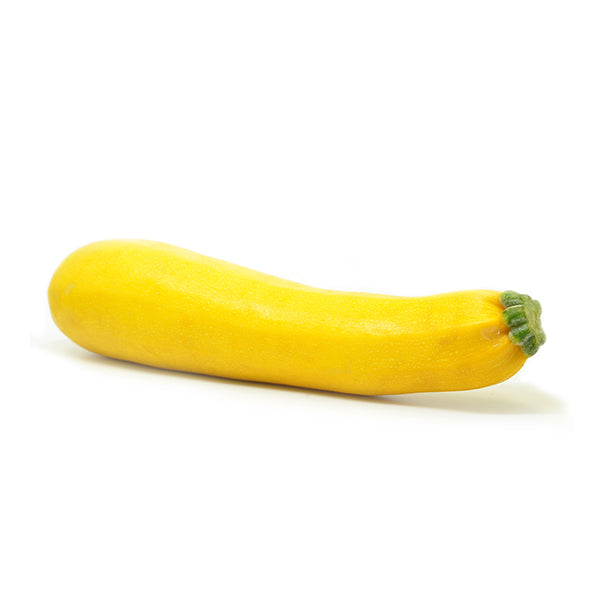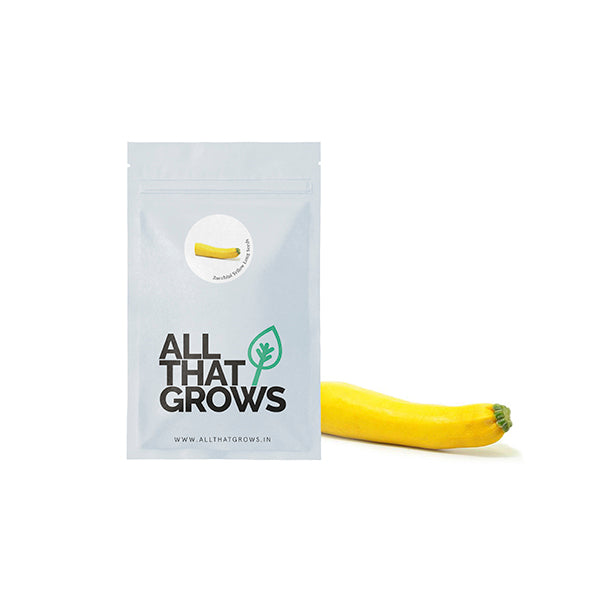



- SOWING
TIMEFeb - Mar
- Sowing
Distanceline to line 4-5 feet and plant to plant 2 feet
- Fruit
Weight100-150 gms
- Fruit
Shapelong
- Days to
maturityafter 45-50 days
- Details
- How to sow
- Reviews
Zucchini is a summer squash that is native to the Americas. Due to its high water percentage, zucchini is low in calories, carbs and sugars, and high in essential nutrients like potassium, manganese, and antioxidants like vitamin C and vitamin A. It helps improve heart health, digestion, control diabetes, lowers cholestrol and can also help improve thyroid. It is a favorite among low-carb dieters and anyone who wants to lose weight quickly. This golden zucchini, is a deep yellow or orange color. You can use it in a variety of recipes: a healthy snack, dips and vegetarian entrée.
Planting instructions
Sow 3 seeds in one spot at a distance of 1 inch. Maintain a distance of 18 inches to 24 inches between plants. If you are growing multiple rows of zucchini, keep a distance of at least 36” between each row. Avoid overhead watering since the wet leaves will attract diseases like Mildew. Only water the soil around the plant.
As the plant grows, remove any withered fruits. You can use these to make compost for your zucchini plants. One well-grown zucchini plant can easily produce enough fruits to feed an average family of 4.
Growing Requirements
Pests & Diseases
Pests: Cutworms, Cucumber Beetles, Squash Bugs, Vine Borers, Spider Mites, Aphids, White Flies. Diseases: Powdery Mildew, Bacterial Wilt, Downy Mildew, Yellow Mosaic Virus, Botrytis Blight. Watering the plants in the morning helps to avoid fungal diseases. Companion plants significantly reduce incoming pests on your crops. Watering down the plants with a strong stream of water followed by an application of diluted neem or castor oil on the pest-affected parts of the plant will help to get rid of them.
soil
Compost rich, well-drained loamy soil with a pH level of 6.0 to 7.5.
spot
Full sun; at least 6-8 hours of sunlight in a day. For transplants, start the seeds indoors in late April or May.
Temperature
The ideal germination temperature for Zucchinis is usually between 15°C to 21°C
Watering
Make sure to keep the soil evenly moist at all times. Zucchini plants can thrive in just 1” of water in a week. However, the crucial time to water your plants would be when they are in the bud-development stage and flowering.
how to harvest
Zucchini should be harvested when they are young and tender, about 6 inches long, before their rinds start to become hard. Use a sharp knife to cut the zucchini fruits from the plants. Zucchini leaves are prickly. Be careful while cutting the fruits. You can wear gloves to protect your hands.
Zucchini can grow 1-2 inches in a day during harvest time. So, check the progress every day. Harvest zucchini regularly to encourage constant production of produce. If you are planning to use the zucchinis from your garden at a later time then make sure you do not wash them before storing. Simply put them in a paper bag with one end open to allow circulation. The zucchinis will remain fresh for about 1 to 2 weeks.

The productiveness of any seed we sell is subject to your local climatic conditions*, the sowing method you adopt, and your commitment to the planting process. We give no warranty, expressed or implied, and are in no way responsible for the produce.
Please note that all our seasonal recommendations/ sowing information is as per the local climatic conditions. *For more information on the optimum conditions required for growing seeds in your region, please contact us at, hello@allthatgrows.in or Whatsapp us at, +91 8544865077
Questions & Answers
Have a Question?
Be the first to ask a question about this.




Zucchini Yellow Long Seeds
Seed Type : Non-Hybrid, Open Pollinated and Non-GMO
Sowing time: February to March
Plants: Vigorous Veins
Fruit size: 100-150 gms
Fruit shape: Round
Fruit color: Shinning green
Flesh color: White
Days to Maturity: 45-50 days after sowing
Zucchini is a summer squash that is native to the Americas. Due to its high water percentage, zucchini is low in calories, carbs and sugars, and high in essential nutrients like potassium, manganese, and antioxidants like vitamin C and vitamin A. It helps improve heart health, digestion, control diabetes, lowers cholestrol and can also help improve thyroid. It is a favorite among low-carb dieters and anyone who wants to lose weight quickly. This golden zucchini, is a deep yellow or orange color. You can use it in a variety of recipes: a healthy snack, dips and vegetarian entrée.
Seed Type : Non-Hybrid, Open Pollinated and Non-GMO
Sowing time: February to March
Plants: Vigorous Veins
Fruit size: 100-150 gms
Fruit shape: Round
Fruit color: Shinning green
Flesh color: White
Days to Maturity: 45-50 days after sowing
- SOWING
TIMEFeb - Mar
- Sowing
Distanceline to line 4-5 feet and plant to plant 2 feet
- Fruit
Weight100-150 gms
- Fruit
Shapelong
- Days to
maturityafter 45-50 days
Planting instructions
Sow 3 seeds in one spot at a distance of 1 inch. Maintain a distance of 18 inches to 24 inches between plants. If you are growing multiple rows of zucchini, keep a distance of at least 36” between each row. Avoid overhead watering since the wet leaves will attract diseases like Mildew. Only water the soil around the plant.
As the plant grows, remove any withered fruits. You can use these to make compost for your zucchini plants. One well-grown zucchini plant can easily produce enough fruits to feed an average family of 4.
Growing Requirements
Pests & Diseases
Pests: Cutworms, Cucumber Beetles, Squash Bugs, Vine Borers, Spider Mites, Aphids, White Flies. Diseases: Powdery Mildew, Bacterial Wilt, Downy Mildew, Yellow Mosaic Virus, Botrytis Blight. Watering the plants in the morning helps to avoid fungal diseases. Companion plants significantly reduce incoming pests on your crops. Watering down the plants with a strong stream of water followed by an application of diluted neem or castor oil on the pest-affected parts of the plant will help to get rid of them.
soil
Compost rich, well-drained loamy soil with a pH level of 6.0 to 7.5.
spot
Full sun; at least 6-8 hours of sunlight in a day. For transplants, start the seeds indoors in late April or May.
Temperature
The ideal germination temperature for Zucchinis is usually between 15°C to 21°C
Watering
Make sure to keep the soil evenly moist at all times. Zucchini plants can thrive in just 1” of water in a week. However, the crucial time to water your plants would be when they are in the bud-development stage and flowering.
how to harvest
Zucchini should be harvested when they are young and tender, about 6 inches long, before their rinds start to become hard. Use a sharp knife to cut the zucchini fruits from the plants. Zucchini leaves are prickly. Be careful while cutting the fruits. You can wear gloves to protect your hands.
Zucchini can grow 1-2 inches in a day during harvest time. So, check the progress every day. Harvest zucchini regularly to encourage constant production of produce. If you are planning to use the zucchinis from your garden at a later time then make sure you do not wash them before storing. Simply put them in a paper bag with one end open to allow circulation. The zucchinis will remain fresh for about 1 to 2 weeks.



 Sign In
Sign In








